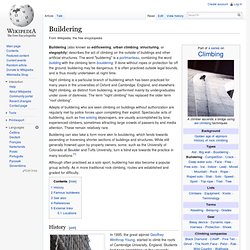

Qinggong. Qinggong[1] (Ching-kung) is a technique in Chinese martial arts.

Its use has been exaggerated in wuxia fiction, where martial artists have the ability to move swiftly and lightly at superhuman speed, perform gravity-defying moves such as gliding on water surfaces, scaling high walls, and mounting trees. [citation needed] In some wuxia and martial arts films containing elements of wire fu, qinggong stunts are simulated by the actor or stuntman suspending himself from wires. [citation needed] In traditional Baguazhang training, qinggong is involved. See also[edit] Parkour References[edit] Freerunning. Freerunning (or free running) is the art of expressing oneself in his or her environment without limitation of movement.

It is a martial discipline founded by Sébastien Foucan, who wrote a book on the subject. Foucan started what he termed "freerunning" in 2003, which he developed as a more inclusive form of parkour, but having more acrobatic-like movements added. Etymology[edit] The word "freerunning" was first used in the documentary, Jump London.[1] The name came about because of a suggestion by Guillaumme Pelletier, who was working with Foucan at the time. The reasoning behind the name was, to quote Foucan, "'Free' because it's free, and just 'running' Philosophy[edit] History[edit] Origins in parkour[edit] In Western Europe the idea of moving past obstacles for personal development or sport originated with Georges Hébert.[5] He observed untrained native tribes in Africa with fantastic athletic ability and created the 'natural method' system to train people using the same ideas.
Buildering. Buildering (also known as edificeering, urban climbing, structuring, or stegophily) describes the act of climbing on the outside of buildings and other artificial structures.

The word "buildering" is a portmanteau, combining the word building with the climbing term bouldering. If done without ropes or protection far off the ground, buildering may be dangerous. It is often practiced outside legal bounds, and is thus mostly undertaken at night-time. Night climbing is a particular branch of buildering which has been practiced for many years in the universities of Oxford and Cambridge, England, and elsewhere. Night climbing, as distinct from buildering, is performed mainly by undergraduates under cover of darkness. Adepts of buildering who are seen climbing on buildings without authorization are regularly met by police forces upon completing their exploit. Although often practised as a solo sport, buildering has also become a popular group activity. History[edit] In 1905, Harry H. Dérive. A 2004 poster announcing a large-scale dérive in London, led by a psychogeographical society In psychogeography, a dérive is an unplanned journey through a landscape, usually urban, on which the subtle aesthetic contours of the surrounding architecture and geography subconsciously direct the travellers, with the ultimate goal of encountering an entirely new and authentic experience.

Situationist theorist Guy Debord defines the dérive as "a mode of experimental behavior linked to the conditions of urban society: a technique of rapid passage through varied ambiances. " He also notes that "the term also designates a specific uninterrupted period of dériving. "[1] History[edit] The dérive continued to be a critical concept in the theory of the Situationist International, the radical group of avant-garde artists and political theorists that succeeded the Letterist International, emerging in the 1950s.
See also[edit] References[edit] External links[edit]